Choosing the right wood for your woodworking or construction project may seem like a daunting task, but it’s actually not as hard as it seems. Here’s the information you need to get started.
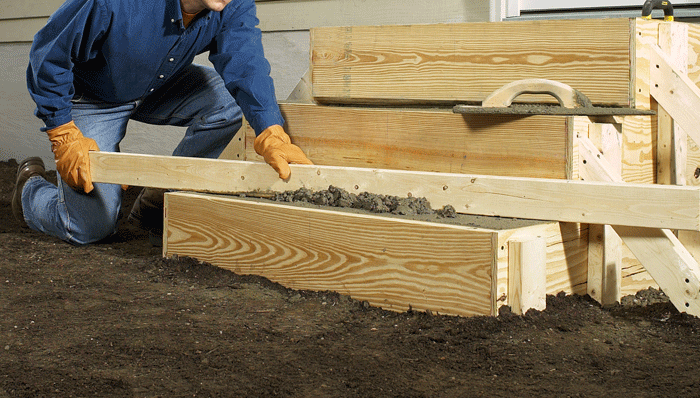
Wood Basics
There are basically two kinds of wood from which to choose: hardwoods and softwoods. The terms have almost nothing to do with the actual hardness of the wood. There are certain characteristics that are common in all wood types.
Hardwoods are the deciduous trees that lose their leaves in the fall. Although there is an abundant variety, only 200 are plentiful and pliable enough for woodworking. Hardwood trees are generally slower-growing, making the wood denser than softwoods. These woods have a more interesting grain pattern which makes them popular with woodworkers. Much like our skin, hardwoods have microscopic pores on the surface. The size of these pores determines the grain pattern and texture. Because of this, hardwoods are classified by pore openings as either: Closed Grained (smaller pores), like cherry and maple or Ring Porous (larger pores), like oak, ash or poplar.
Softwoods come from coniferous trees, commonly referred to as evergreen trees. Only 25 percent of all softwoods are used in woodworking. Softwoods have a closed grain (small pores) that is not very noticeable in the finished product. The most popular softwoods are cedar, fir, pine and spruce. Softwoods are faster-growing, with straighter grain; good for framing, construction and outdoor projects.
Lumber is available in a wide variety of sizes and products. When you shop for lumber, you may notice two sizes listed — Common and Actual. There’s a good reason for this.
Treated Lumber
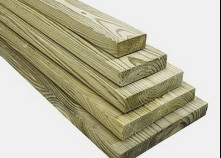
Treated lumber is produced for exterior use only and pressure treated for ground or above ground contact. It is resistant to rotting and insect damage. Boards can be painted or stained. Make sure you choose the right fastener (galvanized or stainless steel) when working with treated lumber.
Decking
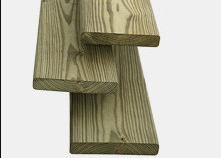
Decking includes floor boards and railing, either composite or treated lumber. Composite decking is manufactured from wood by products and plastic. It is denser, heavier and longer lasting (and more expensive) than treated wood. Decking products are milled with rounded edges, ready to cut and install.
Dimensional Lumbers and Studs

Plywood and OSB
Plywood and OSB panels are manufactured (engineered) from various wood products and by-products. Plywood is produced by layering thin sheets of wood. Oriented strand board (OSB) is made from flakes or chips of wood. Both are made with glue or resin and cured under heat and pressure. These products are used for shelving, subfloors, sheathing and a number of other applications.
Boards
Boards include a broad category of products used for light construction, crafts, woodworking projects, cabinetry, furniture, shelving, internal joinery and moulding. Boards can be stained or painted. Larger boards may be edge-glued (two or more boards glued together to provide a wider size) or solid.
Grades
Hardwood Grade
Grading designation depends on the number of defects in a board. A lower grade can be perfectly acceptable, depending on placement and usage. Hardwoods are graded by the National Hardwood Lumber Association. Here’s a chart to help explain the grading system. Grades are listed from highest to lowest.

Softwood Grade
Softwoods are divided into two categories: dimensional lumber, with a grade based on strength, and appearance boards, which are typically used for woodworking projects. Grades listed here are from highest to lowest.
C Select = Almost completely clear of defects. Widely used for interior trim and cabinets.
D Select = Fine appearance, similar to C Select. May have dime-sized knots.
1 Common = Best material for high quality pine with a knotty look. Knots will be tight, meaning they won’t fall out, and are generally small.
2 Common = Tight knots, but larger than found in 1 Common. Often used for paneling and shelving. Very suitable for general woodworking projects.
3 Common = Knots larger than in 2 Common. Also used for paneling and shelving, but especially well-suited for fences, boxes and crates.
Grade Stamp

While lumber of the same species and size is at the mill, it is designated and separated by grade. It is then identified by a stamp and often inventoried by its grade and species. When selecting wood, be sure you look for its grading stamp because different lumberyards sometimes use different names for the same grade. Remember, if you are having trouble figuring it all out, ask for help. Grade designations depend on particular defects such as knots or wane. Keep your project final results in mind when selecting the grade of wood. Grade does not indicate consistency of color or grain patterns.
Manufacturer: Mill’s number, name or symbol. (ex. 12)
Certification mark: Symbol of agency providing quality control supervision. (ex. WWP®)
Grade: Often abbreviated. 1 Common shown. (ex. 1COM)
Moisture content (MC): Abbreviations for MC when board surfaced: MC 15 is 15 percent or less; KD or S-DRY is 19 percent or less; S-GRN is green wood with more than 19 percent MC. (Ex. S-DRY)
Species mark: Symbol or abbreviation for types of tree. Example shown is Ponderosa pine. (Ex. PP)
Lumber Definitions
In addition to hardwoods and softwoods, there are certain characteristics that are common in all wood types.
Density
Heavy woods like oak are identified by their weight and tight grain pattern and resist wear, dents and scratches better than softwoods.
Texture
Texture is the wood property that determines the condition of the surface and its stability. It plays an important role in deciding how a wood is finished.
Color
Color contributes to the personality of wood. For example, red cedar will give you a very different look and character than white pine.
Wood Grain
Each tree has its own grain pattern, so two boards of the same species can look very different. Wood grain is the direction in which the wood cell fibers grow. These variances in grain direction can have a significant impact on your project.
The grain direction is important to consider when building either structural projects or decorative projects such as furniture or crafts. For instance, when working on a structural application, a straight-grained board is generally the strongest. In more decorative projects, grain with varying characteristics can add beauty and personality to the project. Grain pattern density determines strength. As you’d expect, a piece of lumber with a tight pattern is stronger than one with a loose grain pattern.
Common Lumber Defects
Defects in wood are natural and appreciated by many woodworkers for the unique character they contribute. However, defects in structural lumber should be kept to a minimum. Below, you’ll find a list of common defects in lumber.
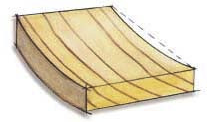
Bow. Warp on the face of a board from end to end.
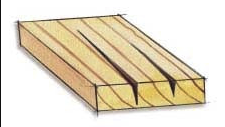
Check. Crack along the wood’s annual growth rings, not passing through the entire thickness of the wood.
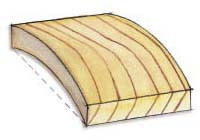
Crook. Warp along the edge line, also known as crown.
Cup. Hollow across the face of a board.
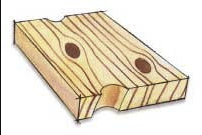
Knot or Knothole. A tight knot is usually not a problem. A loose or dead knot, surrounded by a dark ring, may fall out or may have already left a hole.
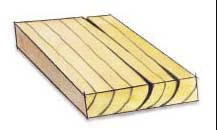
Shake. Separation of grain between the growth rings, often extending along the board’s face and sometimes below its surface.
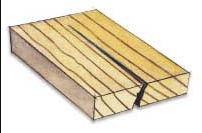
Split. Crack going all the way through the piece of wood, commonly at the ends.
Twist. Multiple bends in a board.

Recent Comments